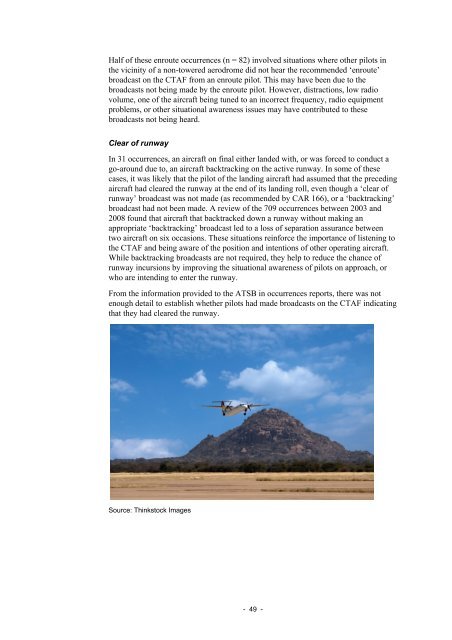Safety in the vicinity of non-towered aerodromes - Australian ...
Safety in the vicinity of non-towered aerodromes - Australian ...
Safety in the vicinity of non-towered aerodromes - Australian ...
Create successful ePaper yourself
Turn your PDF publications into a flip-book with our unique Google optimized e-Paper software.
Half <strong>of</strong> <strong>the</strong>se enroute occurrences (n = 82) <strong>in</strong>volved situations where o<strong>the</strong>r pilots <strong>in</strong><br />
<strong>the</strong> vic<strong>in</strong>ity <strong>of</strong> a <strong>non</strong>-<strong>towered</strong> aerodrome did not hear <strong>the</strong> recommended ‘enroute’<br />
broadcast on <strong>the</strong> CTAF from an enroute pilot. This may have been due to <strong>the</strong><br />
broadcasts not be<strong>in</strong>g made by <strong>the</strong> enroute pilot. However, distractions, low radio<br />
volume, one <strong>of</strong> <strong>the</strong> aircraft be<strong>in</strong>g tuned to an <strong>in</strong>correct frequency, radio equipment<br />
problems, or o<strong>the</strong>r situational awareness issues may have contributed to <strong>the</strong>se<br />
broadcasts not be<strong>in</strong>g heard.<br />
Clear <strong>of</strong> runway<br />
In 31 occurrences, an aircraft on f<strong>in</strong>al ei<strong>the</strong>r landed with, or was forced to conduct a<br />
go-around due to, an aircraft backtrack<strong>in</strong>g on <strong>the</strong> active runway. In some <strong>of</strong> <strong>the</strong>se<br />
cases, it was likely that <strong>the</strong> pilot <strong>of</strong> <strong>the</strong> land<strong>in</strong>g aircraft had assumed that <strong>the</strong> preced<strong>in</strong>g<br />
aircraft had cleared <strong>the</strong> runway at <strong>the</strong> end <strong>of</strong> its land<strong>in</strong>g roll, even though a ‘clear <strong>of</strong><br />
runway’ broadcast was not made (as recommended by CAR 166), or a ‘backtrack<strong>in</strong>g’<br />
broadcast had not been made. A review <strong>of</strong> <strong>the</strong> 709 occurrences between 2003 and<br />
2008 found that aircraft that backtracked down a runway without mak<strong>in</strong>g an<br />
appropriate ‘backtrack<strong>in</strong>g’ broadcast led to a loss <strong>of</strong> separation assurance between<br />
two aircraft on six occasions. These situations re<strong>in</strong>force <strong>the</strong> importance <strong>of</strong> listen<strong>in</strong>g to<br />
<strong>the</strong> CTAF and be<strong>in</strong>g aware <strong>of</strong> <strong>the</strong> position and <strong>in</strong>tentions <strong>of</strong> o<strong>the</strong>r operat<strong>in</strong>g aircraft.<br />
While backtrack<strong>in</strong>g broadcasts are not required, <strong>the</strong>y help to reduce <strong>the</strong> chance <strong>of</strong><br />
runway <strong>in</strong>cursions by improv<strong>in</strong>g <strong>the</strong> situational awareness <strong>of</strong> pilots on approach, or<br />
who are <strong>in</strong>tend<strong>in</strong>g to enter <strong>the</strong> runway.<br />
From <strong>the</strong> <strong>in</strong>formation provided to <strong>the</strong> ATSB <strong>in</strong> occurrences reports, <strong>the</strong>re was not<br />
enough detail to establish whe<strong>the</strong>r pilots had made broadcasts on <strong>the</strong> CTAF <strong>in</strong>dicat<strong>in</strong>g<br />
that <strong>the</strong>y had cleared <strong>the</strong> runway.<br />
Source: Th<strong>in</strong>kstock Images<br />
- 49 -
















